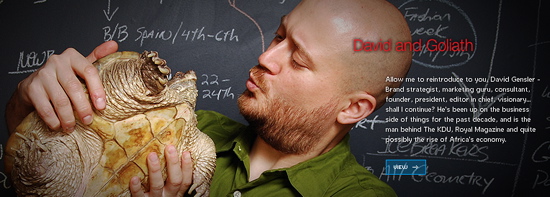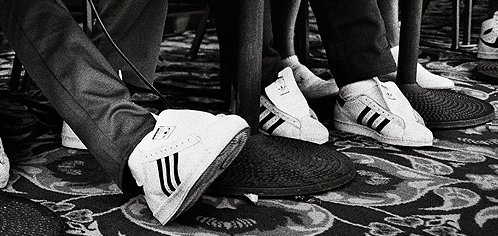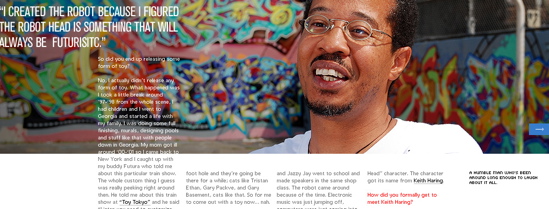SpearTalks: Greg Washington

According to Greg Washington, print is dead. Well, maybe not quite dead – but on a respirator, losing consciousness, and rapidly deflating from the monster that is was to the mouse that it will be.
As the Art Director/Photographer of online culture magazine Inquiringmind, Washington is arguably one of the only people with the right to make such a claim. Unlike other online publications hoping to take the place of our periodical standbys, Inqmnd seems to believe something that its fellow compatriots fail to grasp: It’s a magazine. A magazine, traditionally speaking, is beautiful; it is composed page by page, word by word, and is as much art as it is literature. It is something you flip through, not something you scroll down, and it’s something you keep on your coffee table. What makes Inqmnd different than members of its genre is that – were your computer in the business of shape shifting – you’d want to keep it on your coffee table.
The reason that Greg Washington believes that print is dying is probably the same reason we want to believe him. For print to die, we need a damn good reason to pull the plug. Give us beauty worth looking at; give us words worth reading; give us an online magazine that is better than a print magazine. Give us Inquiringmind.
Joshspear.com: You have a thorough history in design and art direction with companies large and small. Where were you, and what did you learn, on the way to Inquiring Mind Magazine?
Greg Washington: My first design gig was for a very small company who did direct marketing. The pay was low and the task was simple; I handled anything that needed graphics. I ended up doing quite a bit of boring product catalog design work. It sucked having to trek out 1.5 hours for minimum pay and boring work so I decided to spice it up by designing my own personal t-shirts during work hours. When the boss found out what I was doing"¦ it was a wrap.
After that, I spent a couple years just honing my computer skills and building my personal portfolio. When the time came for me to find something, I applied as an intern for Concrete Communications. I learned a thing or two about editorial design and preparing files for print from my short time at that print house. As an intern, I obviously did a lot of bullshit work, but the folks there really supported me and really helped me learn as much as I could.
From there, I landed a job as an in-house junior designer in the marketing department for a clothing company called Bluenotes, but just six months after I was hired the company was sold and the marketing department was totally destroyed. I didn’t really learn much there, but it was fun and so were my teammates.
Until that point my experience was all print related, but during those introductory years I was messing around with Flash a lot and genuinely having fun with it. With every print job I did, I continued to learn more and more flash on the side until I came to the conclusion that there were more job opportunities, and more money for people who knew Flash (and for me, it was simply more fun). So after my stint at Bluenotes, I went back into grind mode, working on my interactive portfolio until I was able to lock down the Interactive Art Director position at Wunderman (Y&R). It was there where I learned about the politics behind the industry, and that working for a Corporate Canadian company with Corporate Canadian clients wasn’t going to satisfy me.
I left to pursue another design job with a smaller agency, where I did a lot of my more recent work, for Nike, Goodfoot, Two Black Guys, etc. Working at this small company was a serious f***king grind. I was running around doing so many random projects that I began to crave the safety of a big, corporate job again. So I flew out to Minneapolis to follow a lead but life happened and I couldn’t get the job. Without enough experience in the field and with no schooling, I wasn’t a candidate for the right type of work Visa.

JS: What inspired you to leave your agency job and help run an online lifestyle magazine?
GW: Following that job in Minneapolis was – kind of – my last major push towards doing the typical 9-5 thing, so when that fell through I was really at ends with what to do with my life. I wanted to do good work, but that wasn’t going to happen with corporate in Canada. I was ineligible to work in the US, and I didn’t want to go overseas, so I really was in between jobs when Mike (Inqmnd founder) hit me up. We had been in touch with each other over that past year for me to be interviewed by the magazine. At the time, I was toying around with the idea of starting my own online magazine, but shortly after the interview launched I started thinking about what it would be like if I applied myself to Inquiringmind – and that idea was exciting. I just loved the name “Inquiringmind,” and when I sat down and really thought about it, I realized there weren’t any REAL online editorial platforms around (there are still only a handful). There were what we used to call “zines” before blogs like Design is Kinky, Being Hunted and a few others happened"¦ but they all seemed like websites rather than my definition of an online magazine (or what COULD be an online magazine). So, instead of starting something new on my own, Mike and I decided to partner up and by the end of that year the all new Inquiringmind was up and running.
JS: You’re a jack-of-all-trades, yet you are entirely self-taught. What gave you the motivation to teach yourself all you needed to know to succeed?
GW: That’s a tricky question. There are those who have become successful by being talented, and there are those who have become successful by working hard. Then there are those who apply both hard work and natural talent to become great. I know I’m not the most talented dude, but I’ll be damned if I’m going to let the next man out hustle me – that’s just the way I am. And if you’re having fun doing it, then it just makes things easier. Being creative is fun, especially when it’s your own company, and you don’t have a client manager with ulterior motives preventing your ideas from seeing the light of day. If we have a good idea, we run with it, simple as that. Beyond that, self-motivation is something that can only be generated if you have a clear goal; if you know what you want out of life, or at least have a pretty good idea. I knew pretty early that I wanted to do interactive design, so I worked hard to make a living out of it. I then realized that in order to be a good director you had to understand a number of other things, so I’ve been pushing myself with the rest of my skill set, like photography. If you know where you want to be, you’ll work as hard as you can to get there. Tim Duncan said something pretty brilliant in the latest Adidas Basketball campaign: “You can get anywhere, from anywhere.” And I’ll just add: if you know where you want to go.
JS: Inqmnd is technically three years old, but underwent a re-launch about a year ago. What’s different about the magazine this year as compared to last?
GW: Everything. Just ask our readers. For starters the first site was HTML, while this new one is flash, and we’re producing way more content than ever. Over the months since the re-design we’ve slowly been turning everything around.
JS: What new attribute of the magazine are you happiest with?
GW: I’m most pleased with the way the magazine was built (behind the scenes). It was fundamentally built to handle any type of content we can think of, and thus far we haven’t been limited by our site framework. Everything works so seamlessly that we’re able to focus on the idea rather than being restricted by our medium. We’ve managed to launch a one-of-a-kind feature for the Nike OneDoor project. We’ve completely redesigned Poppin’ Tags and turned it into a very unique online style directory. There’s so much more fresh content that’s coming this year – it’s going to shock you. So to answer your question, I’m definitely happiest with the flexibility of the framework. It’s simply amazing. And I have to give credit to Matt Rixx for banging that shit out. He’s a gorilla.
JS: Where does it seem like Inqmnd is developing the most?
GW: We are focused on content. We have a mission to bring our readers the most diverse content, the most inspirational content, and the highest quality content. It’s not a game of quality vs. quantity; our choice is obvious. People have already started to copy how we do things, were more concerned with the quality of our content. We’re not here to play the numbers game or the “hits” game. We’re not going to be like “Oh we have millions upon millions of hits, every month!” We get a modest amount of readers, but if you ask them about us, they’re as passionate about what we’re trying to do as we are. Real recognizes real. Everyday we’re asking ourselves, “How can we make this better?”

JS: We love Inqmnd’s Buyers Buybles. I assume it’s you who puts those together so beautifully, but what role do you play in initially deciding what goes in them?
GW: The Buyers Buyble is just one of our segments that is constantly improving. As a team we all have input as to what goes into the Buyble because our target audience is ourselves. No one knows our audience better than we do because we’re living it. At times we fight about what should or shouldn’t go into it, but at the end of the day, we’re putting our name behind those products because we truly have that appreciate for it. And yeah, you can’t please everybody. There’s always going to be that dude who thinks something we featured is wack, or that we’re missing something. That’s just the way it is. All I can say to that person is that we’re going to keep things moving. If this one didn’t vibe with you, maybe the next one will"¦ or maybe it won’t. Either way, we’re featuring products and brands we stand behind regardless.
JS: Online magazines are growing in popularity everywhere, but it seems like they’re particularly hyped in Canada. What do they have that print magazines don’t?
GW: Really? Who else has an online magazine in Canada?
There are so many things that separate web from print content, but I’ll just stick to the topic of media delivery – for real, this is a loaded question"¦
The one MAJOR factor that separates the analog from digital world is accessibility. By the time information makes its way through the print process, onto the shelves and into reader’s hands, it’s been seen a million times online, so it isn’t as fresh. People want to be on the very cusp of news and social happenings, people want to be in the know and stay in the know, so they turn to the medium that can nourish that instantaneous relief, the web. People in the print and broadcast industries have a few hundred people who dig to find news, but there are millions upon millions of people, online, reporting the news from their own broadcast channels in the form of community portals, blogs, personal websites etc. – and if you have an RSS feed, all that lovely information is coming right to your doorstep. There’s just too much actual news happening in the world for traditional media to keep up with.
All the other defining attributes that separate online magazines from print ones come with the difference of the medium itself; the ability to link and pull resources from all over the world together onto one page, the ability to use motion and sound to deliver content in a interesting and captivating manner, (not unlike broadcast). And don’t forget the ability to create a platform where people from every point on the globe can come and interact with one another. HUGE!
But I will say this. The one thing print and broadcast have over web content is quality control. Traditional media companies have teams dedicated to making sure content is accurate and presented properly, with a true sense of care, and almost none of the same mentality has transferred to delivering web content. I mean, there are a few sites that maintain a level of exceptional quality, but it’ll be a while before companies can truly see the medium for what it is. The revolution is coming. Big companies are starting to see how important the medium has become; everyone wants to know what’s happening online. Just take a look at their budgets. Online advertising dollars spent in 2006 completely blew the roof off all expectations, and that isn’t expected to change anytime soon.
JS: Inqmnd has one of the most classical print layouts of all the online magazines I’ve browsed through. Is this intentional?
GW: When readers come to our site after having visited all the other (blogs), they are taken back by how different everything feels, and how similar it feels to print. We seriously try to put as much effort and time into making sure our content is as good online as any good offline editorial. This allows us to capture the ever so slight attention span of our readers, while piggybacking their trained reading habits of magazine content.

JS: Personally, I’ve always felt that there is something unique about holding a paper magazine in my hands – like it’s somehow more intimate and relaxing. Do you feel like the paper magazine is on its way out, or does it still offer something an online magazine could never stand up to?
GW: Paper is on its decline, but is far from on its way out. Costs are up while readership is down. Competing with the instantaneity of online content is really taking a toll on print publications. Why pay $XXX for a print magazine when you can get the same content online months in advance? It’s a hard battle, and print is losing. Until the quality of online content delivery begins to rival the traditional mediums, print will still be around"¦ just keep in mind that the first personal computer came out in 1989 and now, in almost 2008, some kids don’t even have text books for their classes, only CD’s.
JS: You had an incredible, award winning portfolio site up from 2004 until recently "“ is that site really done for good? Are you working on a new one?
GW: I used to bookmark SO MANY portfolio sites. I used other designer portfolios to motivate me to produce a better one. But I was very disappointed to notice that all the best designers with the strongest portfolios never updated their sites. I used to get very frustrated, but after a few years I realized why. Good designers are too busy doing actual work. After I realized that, it all made sense. I’m not going to concern myself with keeping myself marketable. I’m just going to focus on the work, and if the time comes then I may put something together"¦ but don’t expect anything any time soon.
